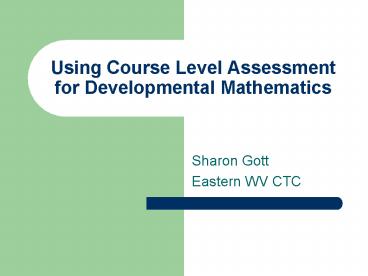Using Course Level Assessment for Developmental Mathematics - PowerPoint PPT Presentation
1 / 30
Title:
Using Course Level Assessment for Developmental Mathematics
Description:
Almost 90% of Eastern's students take at least one developmental course. 2 ... Plan to assess learning outcomes over a brief period of time ... – PowerPoint PPT presentation
Number of Views:62
Avg rating:3.0/5.0
Title: Using Course Level Assessment for Developmental Mathematics
1
Using Course Level Assessment for Developmental
Mathematics
- Sharon Gott
- Eastern WV CTC
2
About Eastern
- Small community and technical college FTE 235
serving over 500 students total - Recently obtained full accreditation by Higher
Learning Commission of North Central Association - Almost 90 of Easterns students take at least
one developmental course
3
Course Level Assessment (CLA)
- All faculty are involved in the process from
outcome selection to input on any action plans - Provide faculty development on CLA and other
assessments activities - CLAs insure outcomes stated in common syllabi are
being met
4
Three Questions
- What are we trying to do?
- How well are we doing it?
- How can we improve what we are doing?
5
Why Assessment?
- Support student learning
- Ensure student academic achievement
- Improve instruction
6
Who Is Involved?
- Academic Services
- Faculty
- Academic Program Directors
- Students
7
Process Level Assessment
- Classroom Level Assessment
- Course Level Assessment
- Program Level Assessment
- Tracking Studies
- course completion, drop rates, pass rates
- Student Surveys
- withdrawing student, course evaluations
8
More than Just a Grade
- Determine attainment of specific learning
outcomes - Provide opportunity for intervention
- Provide information to improve teaching methods
9
Course Level Assessment
- Determines attainment of intended course level
learning outcomes - Identifies need for refinement of course
materials and learning outcomes - Examines role of course in meeting program level
learning outcomes - Assessment involving multiple sections of same
course
10
The Assessment Implementation Cycle - AMATYC
- Define/Refine student learning outcomes based on
input from stakeholders. - Master Course Record Forms include course
outcomes, course fit in curriculum, and any other
pertinent information
11
The Assessment Implementation Cycle - AMATYC
- Design assessment tools, criteria, and standard
directly linked to each outcome. - Written work,
- collaborative activities,
- online exercises,
- and tests/exams.
- CLAs for developmental based on exit exams with
goal of 80 attainment per outcome assessed.
12
The Assessment Implementation Cycle - AMATYC
- Implement assessment tool(s) to gather evidence
of student learning. - - CLAs for developmental based on exit exams
with goal of 80 attainment per outcome assessed
13
The Assessment Implementation Cycle - AMATYC
- Analyze and evaluate the collected data.
- - Select 4-5 outcomes each assessment to review.
14
The Assessment Implementation Cycle - AMATYC
- Identify gaps between desired and actual results.
- - Our goal is 80 attainment on each outcome,
examine questions where we fall short
15
The Assessment Implementation Cycle - AMATYC
- Document results and outline needed changes in
curriculum, instructional materials, or teaching
strategies. - - CLA action plan section.
16
Course AssessmentMTH 95 Introductory Algebra
ISpring 2007
- Four Course Outcomes selected
- Outcome 1 Use order of operations
- Outcome 2 Solve linear equations
- Outcome 3 Graph linear equations
- Outcome 4 Multiply polynomials
17
MTH 95 - Spring 2007 OutcomesAttainment Levels
18
Course AssessmentMTH 96 Introductory Algebra
IISpring 2007
- Four Course Outcomes selected
- Outcome 1 Solve factorable equations
- Outcome 2 Simplify radical expressions
- Outcome 3 Solve linear systems
- Outcome 4 Use quadratic formula
19
MTH 96 - Spring 2007 OutcomesAttainment Levels
20
Changes to Introductory Algebra courses
- Switched content on polynomials from 1st semester
course to 2nd semester course. - Switched content on linear systems of equations
from 2nd semester course to 1st semester course.
21
Course AssessmentMTH 95 Introductory Algebra
ISpring 2008
- Four Course Outcomes selected
- Outcome 1 Use order of operations
- Outcome 2 Solve linear equations
- Outcome 3 Graph linear equations
- Outcome 4 Solve linear systems of equations
22
MTH 95 - Spring 2008 OutcomesAttainment Levels
23
Course AssessmentMTH 96 Introductory Algebra
IISpring 2008
- Four Course Outcomes selected
- Outcome 1 Solve factorable equations
- Outcome 2 Simplify radical expressions
- Outcome 3 Multiply polynomials
- Outcome 4 Use quadratic formula
24
Introductory Algebra OutcomesAttainment Levels
25
Summary of changes in attainment rates New
Introductory Algebra I
- Use order of operations 83 to 87
- Solve linear equations 48 to 65
- Graph linear equations 57 to 80
- Solve linear systems 75 to 66
26
Summary of changes in attainment rates New
Introductory Algebra II
- Solve factorable equations 60 to 74
- Simplify radical expressions 59 to 69
- Multiply polynomials 72 to 94
- Use quadratic formula 65 to 79
27
Course Level Assessment
- What did we learn?
- Why is this important?
- How will we use this information?
28
Closing the Feedback Loop
- Main purpose of assessment Improvement
- Share results with those involved
- Note how findings will be used to improve
learning - Share results with others in the College
29
Final Notes
- Focus assessment efforts on key areas of concern
- What do you really want to know
- Dont try to assess everything at once
- Plan to assess learning outcomes over a brief
period of time - Use different types of assessment techniques
- direct and indirect measures
- Assessment activities will evolve over time.
- If something is not working or new questions have
come up, it is OK to change the way you assess - If you note areas of concern or successes, share
that information with your Academic Program
Director
30
- Sharon Gott
- sgott_at_eastern.wvnet.edu































